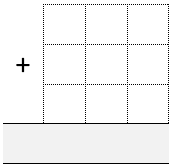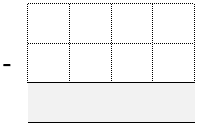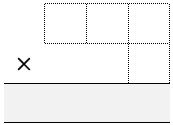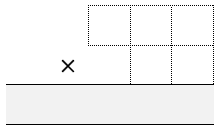Copyright © University of Cambridge. All rights reserved.
Dicey Operations
This game follows on from Nice or Nasty
Again, there are several games to choose from.
Find a partner and a 1-6 dice, or preferably a 0-9 dice if you have one. The interactivity in Dice and Spinners can be used to simulate throwing different dice.
Take turns to throw the dice and decide which of your cells to fill. This can be done in two ways:
either fill in each cell as you throw the dice or collect all your numbers and then decide where to place them.
Game 1
Each of you draw an addition grid like this:

Throw the dice nine times each until all the cells are full.
Whoever has the sum closest to 1000 wins.
There are two possible scoring systems:
- A point for a win. The first person to reach 10 wins the game.
- Each player keeps a running total of their "penalty points", the difference between their result and 1000 after each round. First to 5000 loses.
You can vary the target to make it easier or more difficult.
Game 2
Each of you draw a subtraction grid like this:

Throw the dice eight times each until all the cells are full.
Whoever has the difference closest to 1000 wins.
There are two possible scoring systems:
- A point for a win. The first person to reach 10 wins the game.
- Each player keeps a running total of their "penalty points", the difference between their result and 1000 after each round. First to 5000 loses.
You can vary the target to make it easier or more difficult, perhaps including negative numbers as your target.
Game 3
Each of you draw a multiplication grid like this:
Throw the dice four times each until all the cells are full.
Whoever has the product closest to 1000 wins.
There are two possible scoring systems:
- A point for a win. The first person to reach 10 wins the game.
- Each player keeps a running total of their "penalty points", the difference between their result and 1000 after each round. First to 5000 loses.
You can vary the target to make it easier or more difficult.
Game 4
Each of you draw a multiplication grid like this:
Throw the dice five times each until all the cells are full.
Whoever has the product closest to 10000 wins.
There are two possible scoring systems:
- A point for a win. The first person to reach 10 wins the game.
- Each player keeps a running total of their "penalty points", the difference between their result and 10000 after each round. First to 10000 loses.
You can vary the target to make it easier or more difficult.
You could introduce a decimal point. The decimal point could take up one of the cells so the dice would only need to be thrown four times by each player. You will need to decide on an appropriate target.
Game 5
Each of you draw a division grid like this:
Throw the dice five times each until all the cells are full.
Whoever has the answer closest to 1000 wins.
There are two possible scoring systems:
- A point for a win. The first person to reach 10 wins the game.
- Each player keeps a running total of their "penalty points", the difference between their result and 1000 after each round. First to 5000 loses.
You can vary the target to make it easier or more difficult.
Game 6
Each of you draw a division grid like this:
Throw the dice six times each until all the cells are full.
Whoever has the answer closest to 100 wins.
There are two possible scoring systems:
- A point for a win. The first person to reach 10 wins the game.
- Each player keeps a running total of their "penalty points", the difference between their result and 100 after each round. First to 500 loses.
You can vary the target to make it easier or more difficult.
Click here for a poster of this problem.
Why play these games?
These games are thought provoking and very engaging. They encourage discussion of place value, mental calculations and estimation, alongside valuable strategic mathematical thinking.
Possible approach
These games follow on from Nice or Nasty
They can be played with 1-6 die but ideally would be played with a decahedral 0-9 dice or a spinner (an interactive 10-sided spinner is available
here).
Invite volunteers (perhaps working in teams of two) to play Game 1 on the board and explain the rules to them and the rest of the class.
When the game is over confirm who has won and explain the scoring system.
Working in teams of two, set the students off on playing Game 1. Depending on your aims for the lesson, offer the simple or more complicated scoring system.
Encourage students to justify their strategies to their partners, and draw their ideas together at the end of the lesson.
Key questions
Why are some cells more significant than others?
How do you decide which targets are appropriate?
What are effective strategies for placing the numbers?
Possible support
If pupils are struggling, they might benefit from trying Dicey Addition. This is a simpler version that uses fewer cells in each game.
Perhaps provide students with number cards that they can move around the grid to consider different options.
Pupils who find estimation difficult could use calculators to check their estimates.
Choose the easiest scoring system or allow calculators for scoring the more difficult version.
Allow pairs of students to play against other pairs, so that they can support each other.
Possible extension
You may wish to move students on to Countdown and Countdown Fractions





